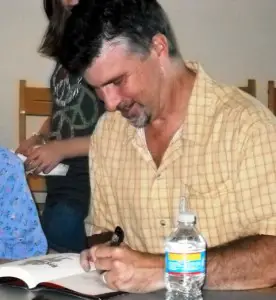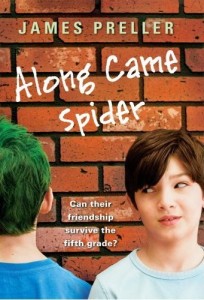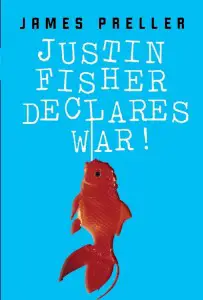 James Preller is an American author of children’s books born in 1961 in Wantagh, New York. He has published numerous books suited for a variety of ages, from picture books to middle grade novels. He is currently writing his first Young Adult novel. In Thailand, he is well known for his Jigsaw Jones Mystery series published by Scholastic. In this interview he talks about his passions for children’s stories, the future of books, writing and his fans.
James Preller is an American author of children’s books born in 1961 in Wantagh, New York. He has published numerous books suited for a variety of ages, from picture books to middle grade novels. He is currently writing his first Young Adult novel. In Thailand, he is well known for his Jigsaw Jones Mystery series published by Scholastic. In this interview he talks about his passions for children’s stories, the future of books, writing and his fans.
Voicu Mihnea Simandan: You have been a story writer for most of your life. How has your writing evolved over time?
James Preller: It’s gotten better, I hope. I suppose I’ve gained awareness of my own writing process – how I work, how I get from the kernel of an idea to a published book. The journey is not always pretty, but I do usually get there in the end. As for the writing itself, I’ve come a long way since college. At first I wrote too much from the “interior,” too inside my characters heads. I had to learn how to get characters talking, moving from room to room, putting on hats and gloves and stepping outside. Show, don’t tell. Since I often draw on my own life for ideas and inspiration, I had to learn how to fictionalize, create distance from the source material and allow new stories to develop on their own. I don’t know if that’s terribly clear. I mean to say, even when I’m drawing on my experiences or my feelings, I learned that I wasn’t writing about me, James Preller. My life was the diving board… the writing was a huge pool of water.
VMS: Where did the ideas of the Jigsaw Jones Mystery series come from?
JP: There are forty books in that series, so at this point I grab ideas from wherever I can. Fortunately, ideas are everywhere. I can’t imagine being alive and engaged in the world and NOT having ideas. I was initially inspired by Raymond Chandler’s “Philip Marlowe” books. The funny thing is, I’m not a puzzle-type writer. The clues and over-arching mystery are not my primary interest. I prefer character, that’s where I almost always begin, and story tends to spring from that.
VMS: Who made the illustrations for the series?
JP: Three different artists have worked on the Jigsaw Jones books. R. A. Alley did the first two, and he still does the covers for each book. John Speirs took over for the interior illustrations for books 3-9. Jamie Smith has carried the ball ever since. I’ve never spoken with, or met, any of these men, though I’ve exchanged emails with “Bob” Alley and Jamie. I should add that Bob helped me on a series of blog entries that take us from initial concept to final cover art – I find that stuff fascinating.
VMS: Until now you have written about thirty-two “cases” that you fictional character, Jigsaw Jones, solved successfully. What will the 33rd book in the series be about?
JP: Correction: 40. There have been “super specials” and a couple of other Jigsaw books, including one that was only available through Scholastic Book Clubs. Right now, my focus has taken me away from Jigsaw. No one ever wants to appear ungrateful for a successful series – books that kids actually READ and ENJOY – but as a writer I needed to try new things.
VMS: You’ve also branched out from beginning chapter books and have written some well-received Middle Grade books. Do you employ similar skills when writing books targeted for an older readership?
JP: Yes, it’s the same job. Writing for younger readers, you can’t assume much prior knowledge. You can’t make an offhand comment about, say, a historical fact. So you have to be extremely clear and take the reader along step-by-step. But as a writer, I prize clarity and directness, so I feel I’ve learned valuable lessons writing for a young audience – lessons that apply to all good writing.
“I think there’s a relationship to the book that
can’t quite be replaced by an e-reader.”
VMS: Everyone seems to believe that children no longer read and, with the availability of affordable e-readers, many believe that, sooner or later, children will no longer want to hold books in their hands. Please comment.
JP: I’m not too worried about reading, per say, though I suppose that sustained attention for longer works might be in some danger. Maybe, I’m not even sure about that. I accept e-readers as a natural fact. Things change. I just downloaded some songs to iTunes, for example, and I grew up loving “albums.” But it’s still music, you know. However, however. I do very much believe in the value of THE TANGIBLE OBJECT, whether it’s a CD or a paperback book. I think there’s a relationship to the book that can’t quite be replaced by an e-reader.
My good friends have a daughter, Lucy, who spent this entire past summer carrying around Twilight in her hands. She read it over and over, the book was frayed and dog-eared, it was used, handled, and so obviously loved. I think the book expressed something essential for Lucy, it became part of her self-identity. She was the girl who carried around that book, a Twilight fan, and on some level she wanted the world to know that fact. Again, e-readers are fine. You want to read the new Michael Connelly novel, an e-reader might be the perfect choice. But I think we’ll always need some real books in our lives. We attach to them easier. They seem to mean more.
VMS: You are very active online and maintain an excellent blog. How important is it for writers these days to be “out there” on the Internet, interacting with their fans?
JP: The most important thing a writer can do is write good books, period. Do good work, that’s only everything. But these days there’s a lot of pressure on authors to self-promote, to have a Facebook page, to tweet and tweet again, to blog and… sigh. It can be done very poorly and get gross, this writer-as-marketer mash-up. At the same time, yes, I think you need to have some web presence, a place where people can find out something about you.
For me, I discovered blogging almost three years ago. I really enjoy it, and find that it gives me an outlet as a writer that I didn’t otherwise have. I’ll comment on an article, or pass along a video, or share some family photos, or talk about books and my writing process. It’s wide open. I don’t know if it makes a whole lot of an impact in terms of sales, but that’s not what sustains me. I am by nature a sharer. We all know people like that. If I see a waterfall, I want you to see it, too. If I hear an amazing song, I want you to hear it. I’m that guy who is always pressing a book into someone’s hands, dragging a friend off to see a concert, and so on. The blog fits my personality.
 VMS: You’ve recently been on quite a few school visits. What were some of the highlights of these visits?
VMS: You’ve recently been on quite a few school visits. What were some of the highlights of these visits?
JP: I juggle with live fire. No, not really. School visits represent an important source of income, frankly. It’s hard work, especially for someone like me, who doesn’t like to take off his slippers. Once I’m there, I love seeing the students, checking in with their reality, looking at the schools and their world. I try to be myself, a regular guy who writes for a living, and I share my love of books and what I do.
VMS: Your “Fathers Read” project is a very interesting one. Can you give us a few details?
JP: Thanks, I’m very excited about it. For many years, I’ve been generally troubled by the gender reading gap. Why don’t more boys read? Long story short: I decided to try to make one positive contribution, thus my new FathersRead.com blog. In it, I hope to primarily feature a wide variety of photos of men… reading. That’s basically it. When I think of all the factors that contribute to a healthy love of reading, I keep coming back to the power of male role models. Look, there’s dad in a chair with a book. The blog will likely expand beyond that, with links to article and comments from guest authors, but at its core I simply want to celebrate men who read. To send the simple message: Reading is a guy thing.
VMS: Do you still read children’s books and young adult fiction?
JP: I mostly read adult books for my own pleasure, though I make sure to read a wide variety of books, including middle-grade and young adult novels. Many are really wonderful and inspiring. I just read Skellig by David Almond and it blew me away.
VMS: What is your writing routine?
JP: I work standard hours. Go down to my desk and try to write each day. I’m not one of those writers who won’t leave the desk until I’ve written X amount of words. A lot depends on where I am in a particular book. Beginnings go very slowly, but as I said up top, now I kind of accept that and it helps cut back on the self-loathing (which is also part of my writing process, I’m afraid).
VMS: What advice would you give to aspiring writers?
JP: Follow your enthusiasms. Read often, and sometimes read slowly, with an awareness of the writer behind the work. If you feel sad or excited or bored by a section of a book, try to reflect on how the writer created those effects in you, the reader. But mostly, and simply, read. And, of course, write. Sometimes people ask me how to become an author, and you have to begin by becoming a writer first. It’s amazing how many people hope to skip that essential step.
VMS: Thank you for your time.
JP: My pleasure.
Voicu Mihnea Simandan
Bangkok, Thailand
November 23, 2010

